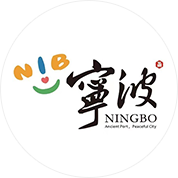The exhibition at the Fenghua Museum
Toward the Plains
“If the Hemudu Culture in the Yao River Valley shows continuous development from its early to late stages, then in the Fenghua River Basin, Hemudu cultural sites are primarily concentrated in the late stage—around 6,000 to 5,300 years ago,” explained Ding Fengya, the excavation team leader from the Ningbo Institute of Cultural Heritage Management and Research.
During this period, as sea levels stabilised, the Hemudu people who originally lived on the foothills, isolated knolls, and raised terraces near the Siming Mountains began to spread into the plains, developing the capacity to live and thrive in low-lying flatlands.
A wooden stilt bridge from the late Hemudu period was unearthed at the Xiawangdu Site.
A heap of pottery shards at the Xiawangdu Site.
The Xiawangdu site in Fangqiao, Fenghua—excavated in 2017—marked the first discovery of a lowland, plain-type Hemudu culture site.
Sites such as Xiawangdu and the later-discovered Hejia site are located several kilometres away from the mountains, indicating that early peoples had developed the courage to leave their familiar upland environments and expand into the plains. However, they retained the habit of building homes on slightly elevated ground—a likely "residual instinct" from long exposure to tidal disruptions.
The dwellings they built were still the stilted longhouses familiar from earlier Hemudu periods. According to Ding Fengya, the buildings in the Fenghua River Basin were either constructed directly on natural ground (as at the Hejia site) or on tamped yellow earth platforms (as at the Gujiazhuang site), where columns were driven into the platform or adjacent areas. Some column bases even had board pads beneath them, with round or square posts set above, offering clearer insight into the Hemudu people’s foundation-laying techniques.
The stilted house remains at the Hejia Site.
Among these, the stilted structure at the Hejia Site is the best-preserved and most complete architectural find of this period, also the best-preserved Hemudu structure discovered so far in the lower Yangtze River region.
This building site contains 71 post holes and two foundation trenches. A long trench runs through the center of the building and once housed floor beams. On the west, north, and east sides, the post holes form enclosed spaces. The southern side connects to a corridor-style passage running northeast to southwest, suggesting a southern entrance.
Although no above-ground architectural remains were found, the layout of post holes allows for a reasonably clear reconstruction of the building’s structural units.

Detail of the stilted house at the Hejia Site
Of the settlements discovered on the plains so far, the Xiawangdu site is the largest. It contains multiple stilted houses, as well as wells, stoves, bridges, fences, and other features—evidence of communal life. In contrast, other sites like Hejia and Gujiazhuang contain no more than one main building. Ding Fengya speculates that these may have served single prehistoric households.
“As more sites are found, we also see a trend: late Hemudu culture settlements are increasingly small and scattered, perhaps with family-based units spread across the plains,” said Ding Fengya.

Detail of a wooden fence from the late Hemudu period at the Chenwang site.
Life and Death Together
Around these dwellings, archaeologists also found wells and burial sites.
Excavations in 1989 and 1991 at the Mingshanhou site in Fenghua uncovered four late Hemudu burials. These were poorly preserved, with no discernible burial pits, coffins, or grave goods. The human remains were in poor condition but identified as supine extended burials, with heads facing northeast.
In contrast, the 2022 excavation of the Gujiazhuang site revealed 12 well-preserved late Hemudu graves. These were located near the earth platform and stilted house, reflecting an integrated spatial layout where living and burial spaces coexisted.

Late Hemudu graves and grave goods at the Gujiazhuang site.
These 12 graves shared similar forms and burial goods. Like the Mingshanhou burials, they were supine extended burials, with heads facing east or northeast. However, the Gujiazhuang graves had wooden coffins—log coffins with concave arc-shaped cross-sections, some with lids, others with just a base, made from camphor wood.
Grave goods were typically placed at the feet or lower limbs of the deceased and included pottery jars, cauldrons, dou (stemmed cups), pedestal basins, stone axes, and adzes. Notably, the pottery cauldrons were smaller than functional ones, suggesting they were ceremonial substitutes (mingqi).
The pottery cauldron (taofu) is one of the most iconic artifacts of the late Hemudu Culture. Many have been unearthed in the Fenghua River Basin, and some are on permanent display in the Fenghua Museum, such as the flared-rim cauldron and the multi-lobed rim cauldron. These were typically paired with ceramic stands and used for cooking food over fire.
Pottery cauldron and stand combination (restored).
The Fenghua Museum also features a “cauldron-stove combination” found in the same ash pit at the Hejia site. “This setup is more stable than a separate stand, easier to move, and more energy-efficient,” said Ding Fengya.
Cauldron-stove combination from the Hejia Site.
As a daily household item, the pottery cauldron was the most common burial good in the late Hemudu Culture, often in miniature form. It’s not surprising that what served them in life was carried with them into death.
The Fate of Hemudu Culture
Long-term archaeological study has revealed that during Phase III of the Hemudu Culture, both the Fenghua and Yao River regions were influenced by the Majiabang Culture from the Lake Tai area. Hemudu pottery collections began to include items such as red-on-the-outside, black-on-the-inside high-stemmed dou and round-cone ding legs, typical of Majiabang artifacts.
By Phase IV, Songze Culture influences were prominent—seen in artifacts like nested-mouth jars, jars with ridged shoulders, wedge-shaped tripod feet, dou handles with hollow triangle decorations. This indicates prehistoric cultural diffusion from north of the Qiantang River into the Ningbo-Shaoxing region.
Pottery with Songze cultural features.
These external cultural influences likely contributed to the diffusion and migration of late Hemudu communities.
As for the ultimate fate of the Hemudu people, scholars continue to debate. Some suggest they vanished due to military defeat, while others speculate that rising sea levels submerged their homeland.
Late Hemudu storage pit at the Chenwang Site.
However, archaeological findings show that the Hemudu Culture had a lasting influence on the region. For example, in the contemporary Liangzhu Culture, funeral customs retained Hemudu traits—such as coffin materials, pottery combinations, and burial arrangements.
Although Liangzhu pottery styles gradually diverged, some Hemudu cauldrons still appear—cauldrons not seen in Liangzhu tradition—highlighting Hemudu Culture’s enduring spiritual legacy.
Source: Yongpai
Reporters: Gu Jiayi, Pan Miao
Editor: Ye Ke











